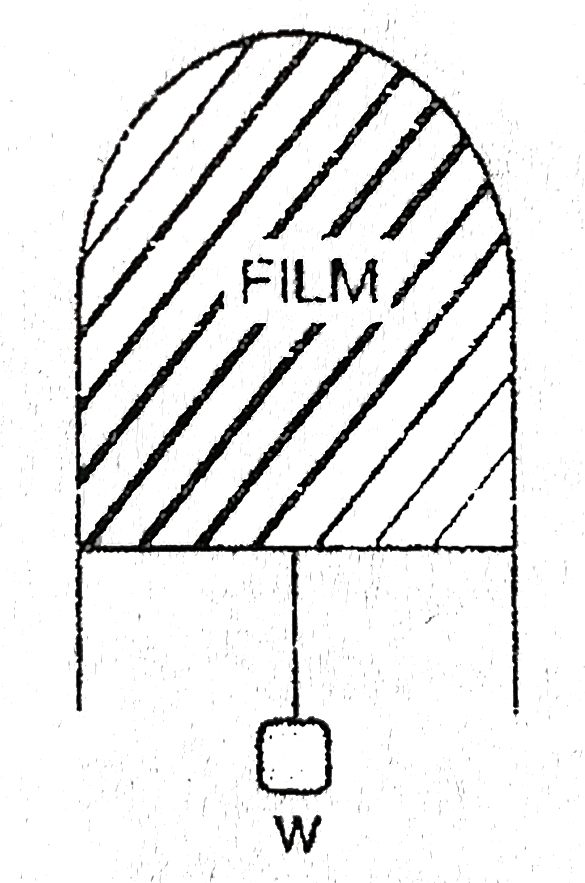Complete Solutions to Surface Tension of chapter MECHANICAL PROPERTIES OF FLUIDS of Class 11 book with complete answers and questions
| Class 11 | PHYSICS |
| Chapter | MECHANICAL PROPERTIES OF FLUIDS |
| NCERT FINGERTIPS | Surface Tension |
| Number Of Questions | 31 |
| Academic Year | 2023-24 |
Which of the following is associated with liquid only and not for gas ?
View SolutionThe rain are in spherical shape due to
View SolutionWhich of the following statements is not true about surface tension ?
View SolutionFor a surface molecule,
View SolutionMercury does not wet glass. This is the property of liquid known as
View SolutionA thin liquid film formed between a `U-`shaped wire and a light slider supports a weight of `1.5 xx 10^(-2)N`(see figure). The length of the slider is `30 cm` and its weight negligible. The surfaces tension of the liquid film is :

View SolutionWhich graph represents the variation of surface tension with temperature over small temperature ranges for water?
View SolutionAngle of contact of a liquid with a solid depends on
View SolutionWhich of the following statements is not true about angle of contact ?
View SolutionWhich of the following statements is correct ?
View SolutionA liquid will not wet the surface of a solid if the angle of contact is
View SolutionThe soap bubble formed at the end of the tube is blown very slowly. Draw the graph between excess of pressure inside the bubble with time.
View SolutionWhen a drop splits up into number of drops
View SolutionThe excess pressure inside a soap bubble is thrice the excess pressure inside a second soap bubble. What is the ratio between the volume of the first and the second bubble?
View SolutionWork `W` is required to form a bubble of volume `V` from a given solution. What amount of work is required to be done to form a bubble of volume `2V` ?
View SolutionFind the work done in blowing a soap bubble of surface tension `0.06 Nm^(-1)` from 2 cm radius to 5 cm radius.
View SolutionThe surface tension of soap solution is `0.03 N//m` . The work done in blowing to from a soap bublle of surface area `40 cm^(2)`, (in J) , is
View SolutionSurface tension of mercury is `0.465 N m^(-1)`. The excess pressure inside a mercury drop of diameter 6mm is
View SolutionThe surface tension of soap solution at a temperature `20^(@)`C is `2.5xx10^(-2) N m^(-1)`.The excess pressure inside a bubble of soap solution of radius 6mm is
View SolutionIn question number 88, if an air bubble of the same dimensions were formed at a depth of 30 cm inside a container containing the soap solution of relative density 1.20, then the pressure inside the bubble is ( Take 1 atm = `1.01 xx 10^(5)` Pa)
View SolutionThe surface tension and vapor pressure of water at `20^(@)`C is `7.28 xx 10^(-2) N m^(-1)` and `2.33 xx 10^(3)` Pa respectively. The radius of the smallest spherical water droplet which can form without evaporating at `25^(@)`C is
View SolutionWhen a capillary tube is dipped in a liquid, the liquid rises to a height H in the tube. The free liquid surface inside the tube is hemispherical in shape. The tube is now pushed down so that the height of the tube outside the liquid is less than H. Then the
View SolutionA capillary tube is taken from the Earth to the surface of the moon. The rise of the liquid column on the Moon (acceleration due to gravity on the Earth is 6 times that of the Moon) is
View SolutionA capillary tube (A) is dipped in water. Another identical tube (B) is dipped in a soap-water solution. Which of the following shows the relative nature of the liquid columns in the two tubes?
View SolutionThe radii of the two columne is U-tube are `r_(1)` and `r_(2)(gtr_(1))`. When a liquid of density `rho` (angle of contact is `0^@))` is filled in it, the level different of liquid in two arms is h. The surface tension of liquid is
`(g=` acceleration due to gravity)
View SolutionThe sap in tree rises in a system of capillaries of radius `2.5 xx 10^(-2) N m^(-1)` and the angle of contact is `0^(@)`. The maximum height to which sap can rise in tree through capillarity action is `(rho_("sap")=10^(3) kg m^(-3))`
View SolutionMercury has an angle of contact equal to `140^(@)` with soda lime glass. A narrow tube of radius `1.00mm` made of this glass is dipped in a through containing mercury. By what amount does the mercury dip down in the tube relative to the mercury surface outside? Surface tension of mercury at the temperature of the experiment is `0.465 Nm^(-1)`. Density of mercury = `13.6xx10^(3) kg m^(-3)`.
View SolutionTwo capillaries of same length and radii in the ratio `1 : 2` are connected in series. A liquid flows through them in streamlined condition. If the pressure across the two extreme ends of the combination is 1 m of water, the pressure difference across first capillary is
View SolutionIf the surface tension of water is 0.06 Nm, then the capillary rise in a tube of diameter 1mm is `(theta=0^(@)`)
View SolutionThe rise in the water level in a capillary tube of radius 0.07 cm when dipped vertically in a beaker containing water of surface tension `0.07 N m^(-1)` is (g = `10 m s^(-2)`)
View SolutionA capillary tube of radius r is immersed in water and water rises in to a height h. The mass of water in the capillary tube is 5g. Another capillary tube of radius 2 r is immersed in water. The mass of water that will rise in this tube is
View Solution
Surface Tension questions and complete solutions for chapter MECHANICAL PROPERTIES OF FLUIDS of NCERT FINGERTIPS PHYSICS (HINGLISH) of Class 11